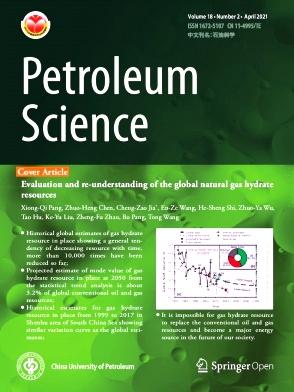Inhibition of wax crystallization and asphaltene agglomeration by core-shell polymer@SiO2 hybride nano-particles
IF 6
1区 工程技术
Q2 ENERGY & FUELS
引用次数: 0
Abstract
The gelation of crude oil with high wax and asphaltene content at low temperatures often results in the block of transportation pipeline in Africa. In recent years, it was reported that surface hydrophobic-modified nanoparticles have important applications in crude oil flow modification. In this work, four kinds of core-shell hybride nanoparticles by grafting poly (octadecyl, docosyl acrylate) and poly (acrylate-α-olefin) onto the surface of nano-sized SiO2 were synthesized by grafting polymerization method. The chemical structure of nanoparticles was analyzed by Fourier transform infrared spectroscopy (FT-IR), scanning electron microscopy (SEM) and thermogravimetric analysis (TGA). The rheological behaviors of crude oil and precipitation of asphaltenes in the presence of nanoparticles were studied by measuring the viscose-temperature relationship curve, the cumulative wax precipitation amount, and morphology of waxes and asphaltenes. The results indicate that the docosyl polyacrylate@SiO2 nanoparticle (PDA@SiO2) can reduce the cumulative wax precipitation amount of crude oil by 72.8%, decline the viscosity of crude oil by 85.6% at 20 °C, reduce the average size of wax crystals by 89.7%, and inhibit the agglomeration of asphaltene by 74.8%. Therefore, the nanoparticles not only adjust the crystalline behaviors of waxes, but also inhibit the agglomeration of asphaltenes. Apparently, core-shell hybride nanoparticles provides more heterogeneous nucleation sites for the crystallization of wax molecules, thus inhibiting the formation of three-dimensional network structure. The core-shell polymer@SiO2 hybride nanoparticles are one of promising additives for inhibiting crystallization of waxes and agglomeration of asphaltenes in crude oil.
核壳聚合物@二氧化硅纳米颗粒抑制蜡结晶和沥青烯团聚
在非洲,蜡和沥青质含量高的原油在低温下凝胶化往往会导致运输管道堵塞。近年来,有报道称表面疏水改性纳米粒子在原油流动改性中具有重要应用。本研究采用接枝聚合法将聚(十八烷基、二十二烷基丙烯酸酯)和聚(丙烯酸酯-α-烯烃)接枝到纳米级 SiO2 表面,合成了四种核壳混杂纳米粒子。通过傅立叶变换红外光谱(FT-IR)、扫描电子显微镜(SEM)和热重分析(TGA)分析了纳米颗粒的化学结构。通过测量粘温关系曲线、累积析蜡量以及蜡和沥青质的形态,研究了纳米颗粒存在时原油的流变行为和沥青质的析出。结果表明,二十二烷基聚丙烯酸酯@SiO2 纳米粒子(PDA@SiO2)可使原油的累积析蜡量降低 72.8%,使原油在 20 °C 时的粘度下降 85.6%,使蜡晶的平均粒径减小 89.7%,抑制沥青质的团聚 74.8%。因此,纳米粒子不仅能调节蜡的结晶行为,还能抑制沥青质的团聚。显然,核壳混杂纳米粒子为蜡分子的结晶提供了更多的异质成核位点,从而抑制了三维网络结构的形成。核壳聚合物@SiO2 Hybride 纳米粒子是抑制原油中蜡的结晶和沥青质团聚的一种很有前景的添加剂。
本文章由计算机程序翻译,如有差异,请以英文原文为准。
求助全文
约1分钟内获得全文
求助全文
来源期刊

Petroleum Science
地学-地球化学与地球物理
CiteScore
7.70
自引率
16.10%
发文量
311
审稿时长
63 days
期刊介绍:
Petroleum Science is the only English journal in China on petroleum science and technology that is intended for professionals engaged in petroleum science research and technical applications all over the world, as well as the managerial personnel of oil companies. It covers petroleum geology, petroleum geophysics, petroleum engineering, petrochemistry & chemical engineering, petroleum mechanics, and economic management. It aims to introduce the latest results in oil industry research in China, promote cooperation in petroleum science research between China and the rest of the world, and build a bridge for scientific communication between China and the world.
文献相关原料
公司名称
产品信息
阿拉丁
n-heptane
¥20.00~¥92897.94
阿拉丁
methanol
|
99%
¥14.00~¥55867.47
阿拉丁
anhydrous ethanol
|
≥99.0%
¥14.00~¥34800.90
阿拉丁
xylene
|
99%
¥15.00~¥8280.00
阿拉丁
?3-Methacryloxypropyltrimethoxysilane (KH570)
|
99%
¥12.00~¥4656.00
阿拉丁
octadecyl methacrylate (SA)
|
99%
¥20.00~¥3540.00
阿拉丁
toluene
|
≥99.0%
¥258.68~¥880.46
阿拉丁
α-24≡28 olefin
阿拉丁
α-20≡24 olefin
 求助内容:
求助内容: 应助结果提醒方式:
应助结果提醒方式:


